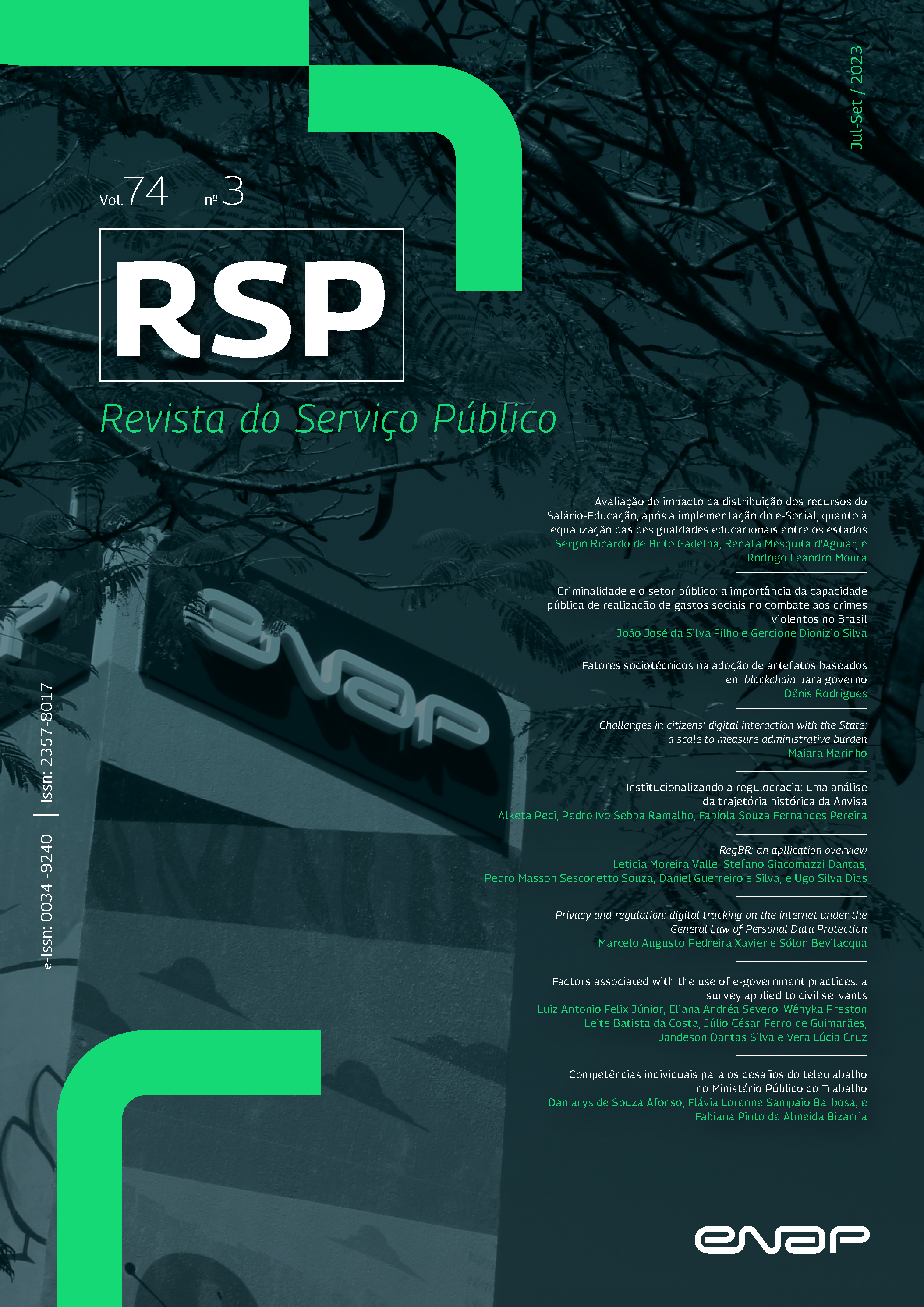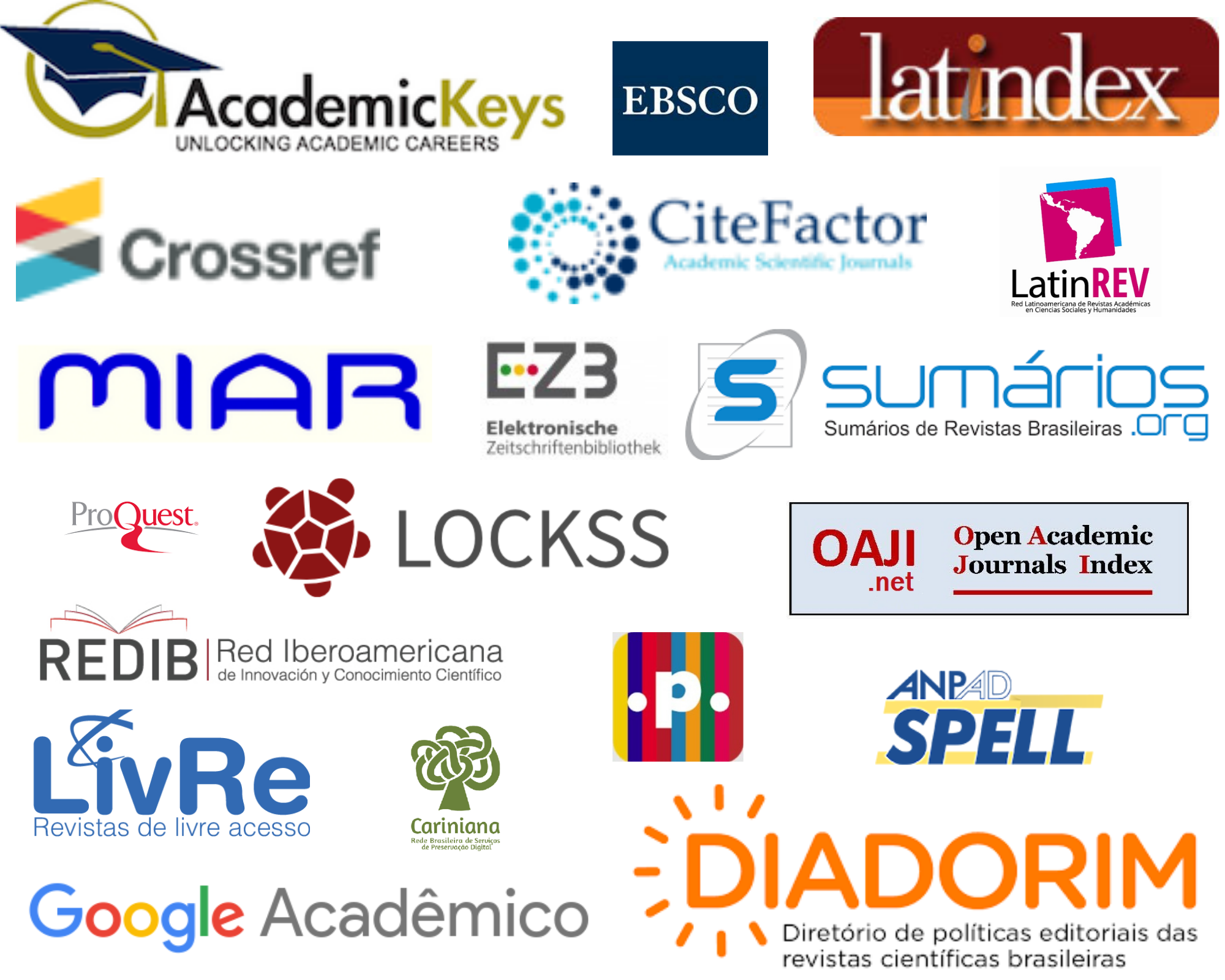Desafíos en la interacción digital de los ciudadanos con el Estado: una escala para medir obstáculos administrativos
Palabras clave:
análisis factorial, invarianza de medida, obstáculos administrativosResumen
En su interacción con el Estado, los ciudadanos se enfrentan a menudo a retos como formularios de elegibilidad, requisitos y normas sin sentido. Estas cargas pueden impedir el acceso a las prestaciones públicas, sobre todo a los pobres, a quienes se considera indignos y con escaso capital social o humano. Algunos abogan por las aplicaciones móviles y los sitios web para facilitar el acceso, pero la tecnología también puede plantear nuevos retos, como costes elevados, amenazas a la privacidad y cargas emocionales y de tiempo. Este trabajo pretende desarrollar una nueva escala para medir las cargas administrativas de los ciudadanos que solicitan prestaciones sociales a través de la interacción digital con el Estado. Se utilizó una muestra no probabilística de 413 encuestados a través de grupos de Facebook dedicados a debatir sobre la Ayuda de Emergencia brasileña. Los resultados mostraron evidencias de fiabilidad y validez de la escala de cargas, pero las limitaciones exigen futuras investigaciones.
Descargas
Citas
Aarøe, L., Baekgaard, M., Christensen, J., & Moynihan, D. P. (2021). Personality and Public Administration: Policymaker Tolerance of Administrative Burdens in Welfare Services. Public Administration Review, 81(4), 652–663. https://doi.org/10.1111/puar.13381
Alon-Barkat, S., & Busuioc, M. (2021). Decision-makers’ Processing of AI Algorithmic Advice: ‘Automation Bias’ versus Selective Adherence. Journal of Public Administration Research and Theory, 1-17. https://doi.org/10.1093/jopart/muac007
Androutsopoulou, A., Karacapilidis, N., Loukis, E., & Charalabidis, Y. (2019). Transforming the communication between citizens and government through AI-guided chatbots. Government Information Quarterly, 36(2), 358–367. https://doi.org/10.1016/j.giq.2018.10.001
Baekgaard, M., Moynihan, D. P., & Thomsen, M. K. (2021). Why Do Policymakers Support Administrative Burdens? The Roles of Deservingness, Political Ideology, and Personal Experience. Journal of Public Administration Research and Theory, 31(1), 184–200. https://doi.org/10.1093/jopart/muaa033
Bell, E., Ter‐Mkrtchyan, A., Wehde, W., & Smith, K. (2021). Just or Unjust? How Ideological Beliefs Shape Street‐Level Bureaucrats’ Perceptions of Administrative Burden. Public Administration Review, 81(4), 610–624. https://doi.org/10.1111/puar.13311
Binns, R. (2018). Fairness in Machine Learning: Lessons from Political Philosophy. Proceedings of Machine Learning Research. Proceedings of Machine Learning Research, 81, 1–11. https://doi.org/10.48550/arXiv.1712.03586
Boas, T. C., Christenson, D. P., & Glick, D. M. (2020). Recruiting large online samples in the United States and India: Facebook, Mechanical Turk, and Qualtrics. Political Science Research and Methods, 8(2), 232–250. https://doi.org/10.1017/psrm.2018.28
Bovens, M., & Zouridis, S. (2002). From Street‐Level to System‐Level Bureaucracies: How Information and Communication Technology is Transforming Administrative Discretion and Constitutional Control. Public Administration Review, 62(2), 174–184. https://doi.org/10.1111/0033-3352.00168
Bozeman, B., & Youtie, J. (2020). Robotic Bureaucracy: Administrative Burden and Red Tape in University Research. Public Administration Review, 80(1), 157–162. https://doi.org/10.1111/puar.13105
Brasil. (2020, August 21). Auxílio Emergencial chega a 60% da população brasileira. Governo do Brasil. https://www.gov.br/pt-br/noticias/financas-impostos-e-gestao-publica/600-dias/arquivos-de-600-dias/cidadania-auxilio-emergencial-chega-a-60-da-populacao-brasileira
Brodkin, E. Z., & Majmundar, M. (2010). Administrative Exclusion: Organizations and the Hidden Costs of Welfare Claiming. Journal of Public Administration Research and Theory, 20(4), 827–848. https://doi.org/10.1093/jopart/mup046
Buffat, A. (2015). Street-Level Bureaucracy and E-Government. Public Management Review, 17(1), 149–161. https://doi.org/10.1080/14719037.2013.771699
Bullock, J., Young, M. M., & Wang, Y.-F. (2020). Artificial intelligence, bureaucratic form, and discretion in public service. Information Polity, 25(4), 491–506. https://doi.org/10.3233/IP-200223
Cardoso, B. B. (2020). The Implementation of Emergency Aid as an exceptional measure of social protection. Revista de Administração Pública, 54(4), 1052–1063. https://doi.org/10.1590/0034-761220200267x
Carney, T. (2020). Automation in social security: Implications for merits review? Australian Journal of Social Issues, 55(3), 260–274. https://doi.org/10.1002/ajs4.95
Castelluccia, C., & Le Métayer, D. (2019). Understanding algorithmic decision-making: Opportunities and challenges. (European Parliament. Directorate General for Parliamentary Research Services., Ed.). European Union. https://data.europa.eu/doi/10.2861/536131
Chen, F. F. (2007). Sensitivity of Goodness of Fit Indexes to Lack of Measurement Invariance. Structural Equation Modeling: A Multidisciplinary Journal, 14(3), 464–504. https://doi.org/10.1080/10705510701301834
Christensen, J., Aarøe, L., Baekgaard, M., Herd, P., & Moynihan, D. P. (2020). Human Capital and administrative burden: The role of cognitive resources in citizen-state interactions. Public Administration Review, 80(1), 127–136. https://doi.org/10.1111/puar.13134
DeVellis, R. F. (2016). Scale development: Theory and applications (Fourth Edition). Sage Publications.
El Akremi, A., Gond, J.-P., Swaen, V., De Roeck, K., & Igalens, J. (2015). How Do Employees Perceive Corporate Responsibility? Development and Validation of a Multidimensional Corporate Stakeholder Responsibility Scale. Journal of Management, 44(2), 619–657. https://doi.org/10.1177/0149206315569311
Eubanks, V. (2018). Automating inequality: How High-Tech Tools Profile, Police, and Punish the Poor (1st ed.). St Martin’s Press.
Fornell, C., & Larcker, D. F. (1981). Evaluating Structural Equation Models with Unobservable Variables and Measurement Error. Journal of Marketing Research, 18(1), 39–50. https://doi.org/10.2307/3151312
George, D., & Mallery, P. (1998). SPSS for Windows Step by Step (world). https://dl.acm.org/doi/abs/10.5555/551591
Hattke, F. (2019). When the Red Tape Becomes Policy: A Critical Assessment of Administrative Burdens. Journal of Public Administration Research and Theory, 30(1), 178–180. https://doi.org/10.1093/jopart/muz025
Heinrich, C. J. (2016). The Bite of Administrative Burden: A Theoretical and Empirical Investigation. Journal of Public Administration Research and Theory, 26(3), 403–420. https://doi.org/10.1093/jopart/muv034
Herd, P., Harvey, H., DeLeire, T., & Moynihan, D. P. (2013). Shifting Administrative Burden to the State: A Case Study of Medicaid Take-Up. Public Administration Review, 73(S1), 69–81. https://doi.org/10.1111/puar.12114
Herd, P., & Moynihan, D. P. (2018). Administrative Burden: Policymaking by Other Means (1 edition). Russell Sage Foundation.
Kleinberg, J., Lakkaraju, H., Leskovec, J., Ludwig, J., & Mullainathan, S. (2018). Human decisions and machine predictions. The Quarterly Journal of Economics, 133(1), 237–293. https://doi.org/10.1093/qje/qjx032
Larsson, K. K. (2021). Digitization or equality: When government automation covers some, but not all citizens. Government Information Quarterly, 38(1), 101547. https://doi.org/10.1016/j.giq.2020.101547
Lee, M. K. (2018). Understanding perception of algorithmic decisions: Fairness, trust, and emotion in response to algorithmic management. Big Data & Society, 5(1), 205395171875668. https://doi.org/10.1177/2053951718756684
Mansur, J., Sobral, F., & Goldszmidt, R. (2017). Shades of paternalistic leadership across cultures. Journal of World Business, 52(5), 702–713. https://doi.org/10.1016/j.jwb.2017.06.003
Masood, A., & Nisar, M. A. (2021). Administrative Capital and Citizens’ Responses to Administrative Burden. Journal of Public Administration Research and Theory, 31(1), 56–72. https://doi.org/10.1093/jopart/muaa031
Michener, G. (2015). Policy Evaluation via Composite Indexes: Qualitative Lessons from International Transparency Policy Indexes. World Development, 74, 184–196. https://doi.org/10.1016/j.worlddev.2015.04.016
Ministry of Development. (2020). Auxílio Emergencial 2020. Secretaria De Avaliação E Gestão Da Informação - Sagi. https://aplicacoes.mds.gov.br/sagi/vis/data3/?g=2
Moynihan, D., Herd, P., & Harvey, H. (2015). Administrative Burden: Learning, Psychological, and Compliance Costs in Citizen-State Interactions. Journal of Public Administration Research and Theory, 25(1), 43–69. https://doi.org/10.1093/jopart/muu009
Nisar, M. A. (2018). Overcoming resistance to resistance in public administration: Resistance strategies of marginalized publics in citizen-state interactions. Public Administration and Development, 38(1), 15–25. https://doi.org/10.1002/pad.1817
Pathki, C. S., Kluemper, D. H., Meuser, J. D., & McLarty, B. D. (2021). The Org-B5: Development of a Short Work Frame-of-Reference Measure of the Big Five. Journal of Management, 014920632110026. https://doi.org/10.1177/01492063211002627
Peeters, R. (2019). The Political Economy of Administrative Burdens: A Theoretical Framework for Analyzing the Organizational Origins of Administrative Burdens. Administration & Society, 52(4), 566–592. https://doi.org/10.1177/0095399719854367
Peeters, R. (2023). Digital Administrative Burdens: An Agenda for Analyzing the Citizen Experience of Digital Bureaucratic Encounters. Perspectives on Public Management and Governance, 6(1), 7–13. https://doi.org/10.1093/ppmgov/gvac024
Peeters, R., & Widlak, A. (2018). The digital cage: Administrative exclusion through information architecture – The case of the Dutch civil registry’s master data management system. Government Information Quarterly, 35(2), 175–183. https://doi.org/10.1016/j.giq.2018.02.003
Podsakoff, P. M., MacKenzie, S. B., & Podsakoff, N. P. (2012). Sources of Method Bias in Social Science Research and Recommendations on How to Control It. Annual Review of Psychology, 63(1), 539–569. https://doi.org/10.1146/annurev-psych-120710-100452
Raisch, S., & Krakowski, S. (2021). Artificial Intelligence and Management: The Automation–Augmentation Paradox. Academy of Management Review, 46(1), 192–210. https://doi.org/10.5465/amr.2018.0072
Samuels, D. J., & Zucco, C. (2013). Using Facebook as a Subject Recruitment Tool for Survey-Experimental Research. SSRN Electronic Journal. https://doi.org/10.2139/ssrn.2101458
Srivastava, M., Heidari, H., & Krause, A. (2019). Mathematical Notions vs. Human Perception of Fairness: A Descriptive Approach to Fairness for Machine Learning. Proceedings of the 25th ACM SIGKDD International Conference on Knowledge Discovery & Data Mining, 2459–2468. https://doi.org/10.1145/3292500.3330664
Suh, H., Shahriaree, N., Hekler, E. B., & Kientz, J. A. (2016). Developing and Validating the User Burden Scale: A Tool for Assessing User Burden in Computing Systems. Proceedings of the 2016 CHI Conference on Human Factors in Computing Systems, 3988–3999. https://doi.org/10.1145/2858036.2858448
Tabachnick, B. G., & Fidell, L. S. (2001). Using Multivariate Statistics (Fourth Edition). Allyn & Bacon.
Thomsen, M. K., Baekgaard, M., & Jensen, U. T. (2020). The Psychological Costs of Citizen Coproduction. Journal of Public Administration Research and Theory, 30(4), 656–673. https://doi.org/10.1093/jopart/muaa001
Veale, M., & Brass, I. (2019). Administration by Algorithm? In K. Yeung & M. Lodge (Eds.), Algorithmic regulation (1st ed., pp. 121–149). Oxford University Press.
Watson, D., Anna, L., & Tellegen, A. (1988). Development and Validation of Brief Measures of Positive and Negative Affect: The PANAS Scales. Journal of Personality and Social Psychology, 54(6), 1063–10170. https://doi.org/10.1037/0022-3514.54.6.1063
Yeung, K. (2019). Why Worry about Decision-Making by Machine? In Algorithmic regulation (1st ed., pp. 21–33). Oxford University Press.
Zouridis, S., van Eck, M., & Bovens, M. (2020). Automated Discretion. In P. Hupe & T. Evans (Eds.), Palgrave handbook on discretion: The quest for controlled freedom (1st ed.). Palgrave Mcmillan.
Descargas
Publicado
Cómo citar
Número
Sección
Licencia
Derechos de autor 2023 Revista do Serviço Público

Esta obra está bajo una licencia internacional Creative Commons Atribución-NoComercial-CompartirIgual 4.0.
- A RSP adota a licença Creative Commons (CC) do tipo Atribuição – Uso Não-Comercial (BY-NC).
- A licença permite que outros remixem, adaptem e criem obra licenciada, sendo proibido o uso com fins comerciais.
- As novas obras devem fazer referência ao autor nos créditos e não podem ser usadas com fins comerciais, porém não precisam ser licenciadas sob os mesmos termos dessa licença.
- Ao publicar o artigo na RSP, o autor cede e transfere para a ENAP os direitos autorais patrimoniais referentes ao artigo.
- O artigo publicado na RSP não poderá ser divulgado em outro meio sem a devida referência à publicação de origem.
- O autor que tiver o artigo publicado na RSP deverá assinar o Termo de Concessão de Direitos Autorais (em momento oportuno a editoria da Revista entrará em contato com o autor para assinatura do Termo).



